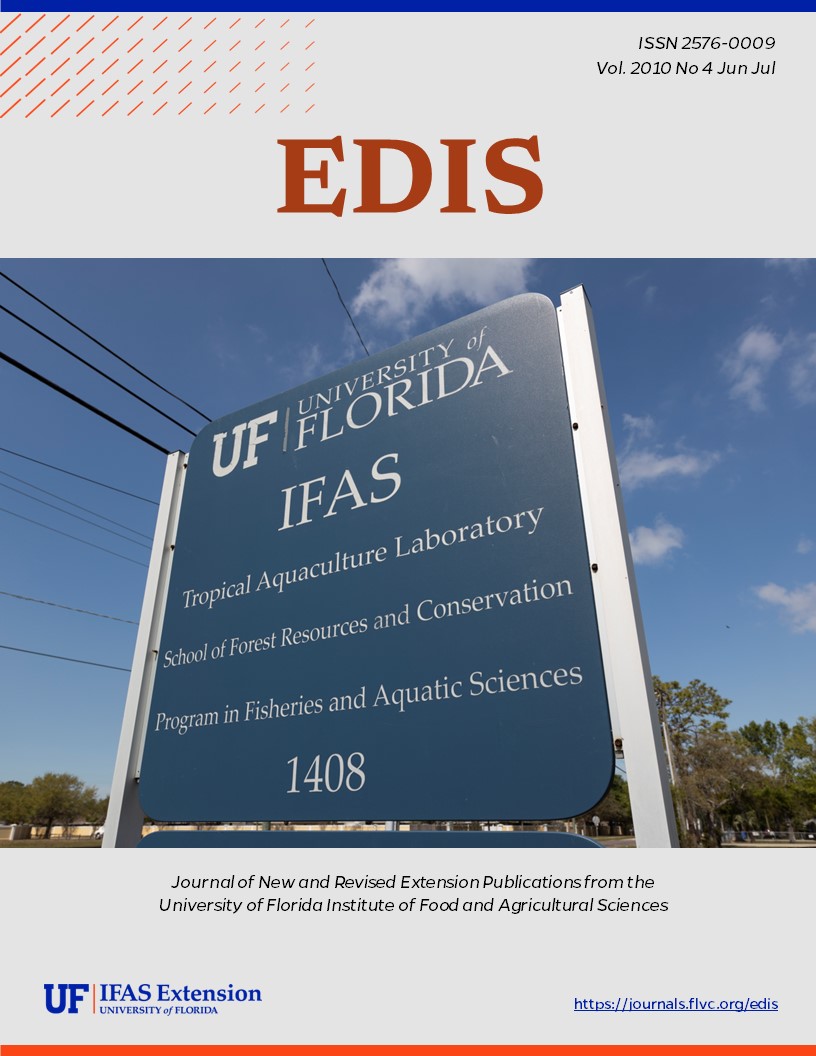Abstract
EENY-475, a 5-page illustrated fact sheet by Rajinder S. Mann and Lukasz L. Stelinski, is part of the Featured Creatures collection. It describes this effective parasitoid of the Asian citrus psyllid, a vector for Huanglongbing disease in citrus — distribution, description, life cycle, hosts, and biological control. Includes references. Published by the UF Department of Entomology and Nematology, June 2010.
References
Aubert B. 1987. Trioza erytreae del Guercio and Diaphorina citri Kuwayama (Homoptera: Psylloidea), the two vectors of citrus greening disease: Biological aspects and possible control strategies. Fruits 42: 149-162.
Aubert B, Quilici S. 1984. Biological control of the African and Asian citrus psyllids (Homoptera: Psylloidea), through eulophid and parasites (Hymenoptera: Chalcidoidea) in Reunion Island. pp. 100-108. In Garnsey SM, Timmer LW, Dodds JA (eds.), Proceedings of the 9th Conference of the International Organization of Citrus Virologists, University of California, 9-13 May 1983, Riverside, CA. University of California, Riverside. https://doi.org/10.5070/C52ND04219
Bové JM. 2006. Huanglongbing: A destructive, newly-emerging, century-old disease of citrus. Journal of Plant Pathology 88: 7-37.
Capoor SP. 1963. Decline of citrus trees in India. Bulletin of National Institute of Science India 24, 48-64.
Chien CC, Chu YI, Ku SC. 1991a. Biological control of citrus psyllid, Diaphorina citri, in Taiwan. II. evaluation of Tamarixia radiata and Diaphorencyrtus diaphorinae for the control of Diaphorina citri. Chinese Journal of Entomology 11: 25-38.
Chien CC, Chu YI, Ku SC. 1991b. Parasite strategy, morphology and life history of Tamarixia radiata (Hymenoptera, Eulophidae). Chinese Journal of Entomology 11: 264-281.
Chien CC. 1995. The role of parasitoids in the pest management of citrus psyllid. Proceedings of the Symposium on Research and Development of Citrus in Taiwan, Taichung, Taiwan, pp. 245-261.
E'tienne J, Quilici S, Marival D, Franck A. 2001. Biological control of Diaphorina citri (Hemiptera: Psyllidae) in Guadeloupe by imported Tamarixia radiata (Hymenoptera: Eulophidae). Fruits (Paris) 56: 307-315. https://doi.org/10.1051/fruits:2001131
Halbert SE. 1998. Entomology Section. Tri-ology. http://www.doacs.state.fl.us/pi/enpp/triology/archive/98-may-jun.htm (14 June 2010).
Halbert SE, Manjunath KL. 2004. Asian citrus psyllids (Sternorrhyncha: Psyllidae) and greening disease in citrus: A literature review and assessment of risk in Florida. Florida Entomologist 87: 330-353. https://doi.org/10.1653/0015-4040(2004)087[0330:ACPSPA]2.0.CO;2
Hall DH. 2008. Biological control of Diaphorina citri. Proceedings of the International Workshop on Huanglongbing of citrus (Candidatus Liberibacter) and the Asian Citrus Psyllid (Diaphorina citri) 7-9 May 2008, Hermosillo, Sonora, Mexico.
Hoy MA, Nguyen R. 2001. Classical biological control of Asian citrus psylla. Citrus Industry 81: 48-50.
Hoy MA, Nguyen R, Jeyparakash A. (2006). Classical biological control of Asian citrus psyllid in Florida. Florida IPM. http://ipm.ifas.ufl.edu/agriculture/citrus/psyllid.shtml (14 June 2010).
León JH, Sétamou M. 2010. Molecular evidence suggests that populations of the Asian citrus psyllid parasitoid Tamarixia radiata (Hymenoptera: Eulophidae) from Texas, Florida and Mexico represent a single species. Annals of the Entomological Society of America 103: 100-120. https://doi.org/10.1603/008.103.0113
Mann RS, Rouseff RL, Smoot JM, Castle WJ, Stelinski LL. 2010. Sulfur volatiles from Allium spp. affect Asian citrus psyllid, Diaphorina citri Kuwayama (Hemiptera: Psyllidae) response to citrus volatiles. Bulletin of Entomological Research (In press). https://doi.org/10.1017/S0007485310000222
Michaud JP. 2002. Invasion of the Florida citrus ecosystem by Harmonia axyridis (Coleoptera: Coccinellidae) and asymmetric competition with a native species, Cycloneda sanguinea. Environmental Entomology 31: 827-835. https://doi.org/10.1603/0046-225X-31.5.827
Michaud JP. 2004. Assessment of cotton as an alternative host plant for the brown citrus aphid, Toxoptera citricida (Homoptera: Aphididae). Florida Entomologist 87: 105-111. https://doi.org/10.1653/0015-4040(2004)087[0105:AOCAAA]2.0.CO;2
Onagbola EO, Boina DR, Hermann SL, Stelinski LL. 2009. Antennal sensilla of Tamarixia radiata (Hymenoptera: Eulophidae), a parasitoid of Diaphorina citri (Hemiptera: Psyllidae). Annals of the Entomological Society of America 102: 523-531. https://doi.org/10.1603/008.102.0324
Pluke RWH, Qureshi JA, Stansly PA. 2008. Citrus flushing patterns, Diaphorina citri (Hemiptera: Psyllidae) populations and parasitism by Tamarixia radiata (Hymenoptera: Eulophidae) in Puerto Rico. Florida Entomologist 91: 36-42. https://doi.org/10.1653/0015-4040(2008)091[0036:CFPDCH]2.0.CO;2
Qureshi JA, Rogers ME, Hall DG, Stansly PA. 2009. Incidence of invasive Diaphorina citri (Hemiptera: Psyllidae) and its introduced parasitoid Tamarixia radiata (Hymenoptera: Eulophidae) in Florida citrus. Journal of Economic Entomology 102: 247-256. https://doi.org/10.1603/029.102.0134
Skelley LH, Hoy MA. 2004. A synchronous rearing method for the Asian citrus psyllid and its parasitoids in quarantine. Biological Control 29: 14-23. https://doi.org/10.1016/S1049-9644(03)00129-4
Waterston J. 1922. On the chalcidoid parasites of psyllids (Hemiptera, Homoptera). Bulletin of Entomological Research 13: 41-58. https://doi.org/10.1017/S0007485300045235

